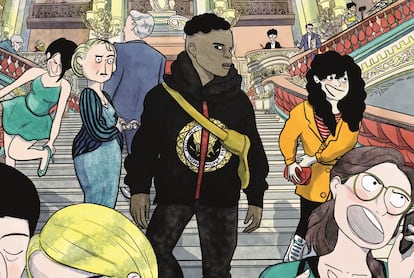Being distinguished: Why the rich like certain things and the poor others
The sociological theories on cultural taste popularized by French thinker Pierre Bourdieu over 45 years ago have reached a wider audience thanks to a graphic novel by Tiphaine Rivière


If you choose a sophisticated salad over fast-food fried chicken, if you prefer living in one neighborhood over another, or wear a casual blazer instead of a tracksuit, it might be seen as a matter of personal taste. And as the saying goes, there’s no accounting for taste.
But it’s not that simple. Our preferences aren’t entirely personal, voluntary, or arbitrary — they are deeply shaped by social class and the environment in which we were raised. “Rich people don’t play golf because they like it,” says Professor Luis Enrique Alonso from the Complutense University of Madrid. They play golf because golf is for rich people.
This is the argument put forth by French sociologist Pierre Bourdieu in what is perhaps his most influential work: Distinction: A Social Critique of the Judgement of Taste (1979). In it, Bourdieu argues that each social class possesses a habitus — a system of dispositions, ways of thinking, lifestyle choices, and cultural tastes. It is through this habitus that individuals define themselves in relation to others, thereby reproducing class distinctions and the dynamics of social domination.
Bourdieu’s theories — particularly his analysis of different forms of capital (not just economic, but also social and cultural) — can be debated and refined in light of a radically transformed world shaped by digitalization and globalization. Still, Distinction remains a cornerstone of sociology. “It looks at us the way the classics do,” says Alonso. “And in France, it continues to be a monument of sociology.”

Bourdieu’s work is studied in a French high school, where a novice teacher tries to introduce the nuances of social inequality to a diverse and initially skeptical group of students. Gradually, however, as they observe their families, the environments they move through, and the differences among themselves, the students begin to recognize some of the sociologist’s insights in their own lives. Being from a working-class family with little interest in high culture or modern design is not the same as being the daughter of a wealthy aesthete who attends the opera and scorns popular music. Distinction, in this way, operates as a form of symbolic domination.
This story of the French high school is told by 42-year-old French author Tiphaine Rivière in La Distinction (The Distinction), a graphic novel that brings to life a dense, 700-page sociological text written in academic language. “I thought it was important to make Bourdieu accessible,” Rivière explains. “He has great emancipatory potential — especially for those social classes that aren’t able to pick up a long book written in complex language.”
Meritocracy, as The Distinction argues and Rivière emphasizes in the graphic novel, is a convenient fiction — one that helps us believe the privileges of the ruling class are truly earned through merit, and that anyone can succeed if they try hard enough. But Bourdieu shows this isn’t the case: in education, rather than leveling the playing field, we validate skills acquired outside of school and reinforce inequality.
“Of course, there are people who manage to change social class and use school as a vehicle for upward mobility,” Rivière notes. “But statistically, social classes largely reproduce themselves, and education doesn’t change anything.” According to Bourdieu, she adds, “school exists to convince the middle and working classes that they are indeed inferior to the ruling class.”
Rivière, like the characters in her graphic novel, experienced Bourdieu’s theories firsthand. After the success of her debut work Notes on a Thesis, which chronicled the struggles of academic life, journalists repeatedly praised her as a self-taught talent who had risen from nowhere to become a bestseller. “That made me proud,” she says. “But I realized that, parallel to this success story, there was another, more real one: I grew up in a very well-off environment.”
Rivière attended private schools, took piano, tennis, and horseback riding lessons, studied literature, and had her apartment paid for by her parents until she was 30. “Obviously, at some point I managed to find a field of expertise. If I had been born somewhere else, I would never have had the space to try my hand at comics or the resources to learn how to draw,” says the author. She also realized that the success stories featured in the media rarely mentioned the privileged backgrounds of their subjects — it always seemed that everything came down to talent and determination. That’s why reading Bourdieu was so eye-opening for her.
“The book was a game-changer because of the way it focused on the sociology of consumption, social stratification based on lifestyles,” says Alonso. “It breaks with the idea of a social structure based solely on economic capital, also taking into account cultural tastes and the construction of the habitus that mediates between the individual and the collective.”
Rivière’s comic format serves this well: it intuitively illustrates each class’s habitus — their gestures, clothing, homes, and style — without needing dozens of pages of description. It also builds empathy with the story’s diverse students and their families.
Bourdieu’s original text wasn’t without critics. He was accused of determinism, reductionism, dominationism, localism, and functionalism. “According to his critics, Bourdieu had overly rigid categories, neglected popular culture, and was too focused on the domination of the upper classes against which nothing could be done, with a kind of fascination with bourgeois culture,” says Alonso.
Bourdieu’s ideas deserve a review because the world has changed a lot. For example, the internet has democratized access to previously restricted cultural materials, and new dynamics like cultural omnivorism — a term coined by Richard Peterson — have emerged. For the upper classes today, everything is on the table. Watching Iranian art films is no longer incompatible with bingeing dating shows (even if ironically), being a free jazz connoisseur, or loving Taylor Swift. Some wealthy artists try to emulate street style, while many working-class kids wear luxury brands — even if they’re knockoffs. In fact, this way of surfing between high and low culture, a hallmark of postmodernism, has become its own form of distinction.
“Everything seems more fluid now,” says Rivière. “Popular culture is everywhere, and most young people wear hoodies and sneakers, regardless of their social class. And yet, I don’t think the system of domination has fundamentally changed.”
Sign up for our weekly newsletter to get more English-language news coverage from EL PAÍS USA Edition
Tu suscripción se está usando en otro dispositivo
¿Quieres añadir otro usuario a tu suscripción?
Si continúas leyendo en este dispositivo, no se podrá leer en el otro.
FlechaTu suscripción se está usando en otro dispositivo y solo puedes acceder a EL PAÍS desde un dispositivo a la vez.
Si quieres compartir tu cuenta, cambia tu suscripción a la modalidad Premium, así podrás añadir otro usuario. Cada uno accederá con su propia cuenta de email, lo que os permitirá personalizar vuestra experiencia en EL PAÍS.
¿Tienes una suscripción de empresa? Accede aquí para contratar más cuentas.
En el caso de no saber quién está usando tu cuenta, te recomendamos cambiar tu contraseña aquí.
Si decides continuar compartiendo tu cuenta, este mensaje se mostrará en tu dispositivo y en el de la otra persona que está usando tu cuenta de forma indefinida, afectando a tu experiencia de lectura. Puedes consultar aquí los términos y condiciones de la suscripción digital.
More information
Archived In
Últimas noticias
Chris Martin, Taylor Swift, Elijah Wood and other famous wedding ‘crashers’
‘How does it feel to be a failure?’: Elizabeth Berkley’s journey from ‘Showgirls’ ridicule to vindication
The story of the Málaga virus: The code that haunted Google’s cybersecurity center director for 30 years
The impact of Ecuador’s mega-prison: A polluted river, cleared forests and military checkpoints
Most viewed
- Christian Louboutin: ‘Young people don’t want to be like their parents. And if their parents wear sneakers, they’re going to look for something else’
- The low-cost creative revolution: How technology is making art accessible to everyone
- Liset Menéndez de la Prida, neuroscientist: ‘It’s not normal to constantly seek pleasure; it’s important to be bored, to be calm’
- All the effects of gentrification in one corner of Mexico’s Colonia Roma
- December Social Security and SSI payments: Dates, double checks and the 2026 COLA increase










































